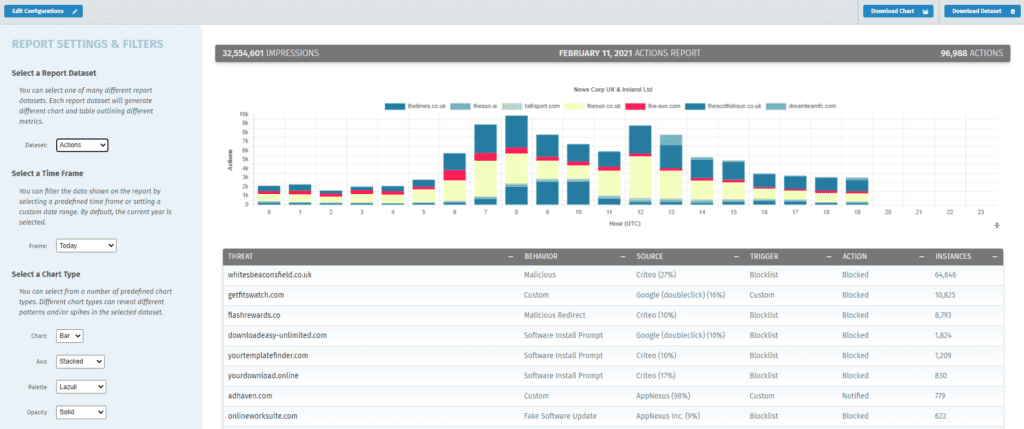Malvertising
What is Malvertising?
Do you know a bad ad when you see it? Probably not, because on the Internet bad ads take many shapes and forms—and often the elements that cause the greatest harm to your site’s visitors are obscured within code and tags.
What makes a bad ad ‘malvertising’?
A portmanteau of malware and advertising (aka “malicious advertising”), malvertising uses the dynamic digital advertising ecosystem (e.g., the open programmatic marketplace) to target consumers with malicious content. Countless bad actors covertly insert malicious code into creatives, tags and/or landing pages via AdTech partners or directly onto publisher websites. Specific examples include:
- Malware directly delivered through a piece of ad creative
- Redirects propagating phishing and other scams
- Advertising landing pages waiting to drop malware on users
- General low-quality ads that boost schemes and fraud
- Inflammatory ads that are discordant with your site’s content and mar user experience
- And unfortunately much, much more…
But how does malvertising affect my site?
Advertising can be a great revenue source for digital publishers of all sizes, but it exposes audiences to a lot of nasty stuff—both through advertising sold by a sales team and indirect sources like the open programmatic marketplace.
Malvertising can lure your visitors into scams, download code that injects additional malicious ads into their browsers (adware), or even steal private information—from logins and passwords to credit card numbers.
How do I defend against malvertising?
As a publisher, it’s your responsibility to offer a space where visitors feel secure and protected. There might be a lot of malvertising flowing through the digital advertising pipes, but it can be mitigated—with the right tools.
Media Filter by The Media Trust is not only the best-performing and smartest creative blocker out there, it’s also easy to deploy, highly customizable, and enables revenue recovery for blocked ads.
Request a free, 45-day trial of Media Filter
- High-quality exclusion/block list content. No one has better data than our malware desk. Our blocklists are constantly curated and powered by our 15 year+ history of continuous client-side scanning of the Internet for malware and other threats.
- Fast and light script. Running at about 50 milliseconds, Media Filter won’t add unnecessary latency woes.
- Quick setup. You can get Media Filter up and blocking in a flash—without straining precious development resources.
- Customization. Integrations and blocklists can be tailored to better fit a publishers’ needs.
- Revenue Recovery. If an ad is blocked, a publisher still has the opportunity to monetize the impression.
Why Media Filter?

The Media Trust has been scanning and keeping tabs on bad actors longer than anyone else in digital advertising. Media Filter uses this expertise to keep your users safe from all the danger lurking in digital advertising—and let you focus on being a first-class publisher. Request a 45-day free trial today!
What's going on at The Media Trust

StringRipper’s Malicious Combo Attack Threatens the Holidays
Super sophisticated phishing redirector marks a frightening evolution in malvertising. Unlike the Grinch trying to steal holiday cheer, threats actors have set about spoiling the season with an incredible barrage of unwanted presents. For the past several months, The Media

Media Filter Beats Back US Election Night Malvertising Barrage
6X rise in attacks held at bay by blocking script, while tech support scams rise week after election. The U.S. presidential election didn’t just bring voters to the polls—it brought bad actors out to cause digital chaos. Just as The

FACTS! If Polyfill Is Still on Your Site… It’s Still a Threat
VP of Product R&D Jason Bickham questions why tech execs think the Polyfill debacle is ‘over.’ Is “Facts!” really a greeting now? Which apparently doesn’t even require context – you can just pound fists and say, “Facts!” I checked with
